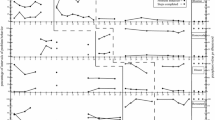Abstract
The family therapy and social control model describes first the relationship between unplanned change and developmental growth. With many families, the family therapist works to both provoke change and encourage growth. However, some out-of-control families present a level of danger to a family member that outside controls, such as child protective services, must be used. This model clarifies the complementary but independent roles of family therapy and social control in helping out-of-control families. Intervention with incestuous families is presented as illustrative of the model.
Similar content being viewed by others
References
Boszormenyi-Nagy, L. & Spark, G. H. (1973).Invisible loyalities. New York: Harper & Row.
Cecchin, G. (1988). Hypothesizing, circularity, and neutrality revisited: An invitation to curiosity.Family Process, 26, 405–413.
Finkelhor, D. (1984).Child sexual abuse. New York: Free Press.
Framo, J. L. (1982).Explorations in family therapy: Selected papers of James L. Framo. New York: Springer.
Giaretto, H. (1981). A comprehesive child sexual abuse treatment program.Child abuse and neglect, 6, 263–278.
Haley, J. (1977). Toward a theory of pathological systems. In P. Watzlawick & J. Weakland (Eds.),The interactional view (pp. 31–48). New York: Norton.
Jackson, D. D. (1965). Family rules: Marital quid pro quo.Archives of General Psychiatry, 6, 589–594.
Karpel, M. A. (1976). Intra-psychic and interpersonal processes in the parentification of children.Dissertation Abstracts International, 38, 365–368.
Minuchin, S. (1974).Families and family therapy. Cambridge, MA: Harvard University Press.
Patterson, G., & Reid, J. (1970). Reciprocity and coercion: Two facets of social systems. In C. Neuringer & J. Michael (Eds.),Behavior modification in clinical psychology. (pp. 133–177). New York: Appleton-Century-Crofts.
Steinglass, P. (1987).The alcoholic family. New York: Basic Books.
Watzlawick, P., Weakland, J., & Fisch, R. (1974). Change:Principles of problem formation and problem resolution. New York: Norton.
Author information
Authors and Affiliations
Additional information
My thanks to the staff of Child Protective Services, the Juvenile Court, Yuma Police Department, Yuma County Sheriff's Department, Adult Probation Department, and the staff and group members of Yuma County, Arizona Parents United for showing that shared concern about the well-being of children can make a real difference in working with families. My appreciation to William C. Nichols, EdD, Elora Cornille and Dale Brotherton for their helpful suggestions on a earlier version.
Rights and permissions
About this article
Cite this article
Cornille, T.A. Family therapy and social control with incestuous families. Contemp Fam Ther 11, 101–118 (1989). https://doi.org/10.1007/BF00892076
Issue Date:
DOI: https://doi.org/10.1007/BF00892076




